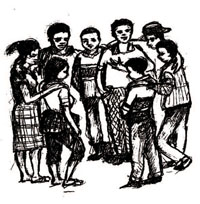Why it is important to provide services for adolescents and young people
The World Health Organization (WHO) defines an adolescent as an individual in the 10-19 years age group and usually uses the term young person to denote those between 10 and 24 years. In this Module we will use these definitions and also the terms early adolescence (10-14), late adolescence (15-19) and post-adolescence (20-24), because they are helpful in understanding the problems and designing appropriate interventions for young people of different ages. You will explore the relevance of this classification in greater detail in Study Sessions 10 and 12 which discuss how you can promote and provide adolescent and youth-friendly reproductive services.
Adolescence is a period of transition from childhood to adulthood during which adolescents develop biologically and psychologically and move towards independence. Although we may think of adolescents as a healthy group, many die prematurely and unnecessarily through accidents, suicide, violence and pregnancy-related complications. Some of the serious conditions of adulthood (for example, sexually transmitted infections (STIs), like HIV; and tobacco use) have their roots in adolescent behaviour.
Studies show that young people are not affected equally by reproductive health problems. Orphans, young girls in rural areas, young people who are physically or mentally impaired, abused or have been abused as children and those migrating to urban areas or being trafficked are more likely to have problems.
Despite their numbers, adolescents have not traditionally been considered a health priority in many countries, including Ethiopia. While the country has been implementing major interventions to reduce child mortality and morbidity, interventions addressing the health needs of young people have been limited. Young people often have less access to information, services and resources than those who are older. Health services are rarely designed specifically to meet their needs and health workers only occasionally receive specialist training in issues pertinent to adolescent sexual health. It is perhaps not surprising therefore that there are particularly low levels of health-seeking behaviour among young people. Similarly, young people in a variety of contexts have reported that access to contraception and condoms is difficult.
The negative health consequences of adolescents can pass from one generation to the next. For example, babies born to adolescent mothers have a high risk of being underweight or stillborn. They are also likely to suffer from the same social and economic disadvantages encountered by their mothers. That is why addressing the needs of adolescents is an intergenerational investment with huge benefits to subsequent generations (see Figure 1.1).

If the nation is to address its rapid population growth, it is crucial to acknowledge the importance of the reproductive health concerns of adolescents and young people, particularly in their decisions related to avoidance of unwanted pregnancy.